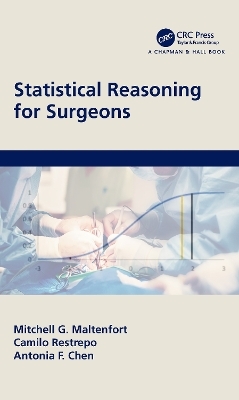
Statistical Reasoning for Surgeons
CRC Press (Verlag)
978-1-138-09179-5 (ISBN)
Trying to read up on statistics can be like trying to decide where you want to start eating the elephant and what’s the most digestible way to get it down. This book is written to give bite-size nuggets of insight based on our experiences grappling with datasets large and small. It is intended to bridge the gap between the formal equations and the practicalities of generating a research manuscript. We won’t pretend reading it will answer all your questions but it will help explain what questions need to be asked for your study and how you can address them with both accuracy and clarity. The size, detail and (ostensible) organization of this book allow for easy reading and can give a leg (or at least a half-step) up for those seeking more detailed study later.
Features include:
Excel sheets to allow exploration of topics raised
Emphasis on intuitive explanations over formulas.
Consideration of issues specific to clinical and surgical studies
Our audience is someone who may or may not have enjoyed formal statistics education (that is, you may have had it and not enjoyed it!) who may like seeing a more dressed-down presentation of the topics. Actual statisticians may pick this up at risk of a chuckle (with us or at us) and may find some useful ways to present topics to non-statisticians.
Mitchell Maltenfort lurched into academic life as a computational neurobiologist before drifting into the less recherché field of biostatistics. He knows just enough to make a complete hash out of things and is creative enough to salvage them afterwards. In his brutish culture, this tradition is known as "larnin'." For tax purposes, he is employed as a biostatistician at CHOP, where he has generated risk scores for hospitalization, analyzed diagnostic variations among clinics, compared international trends in childhood mortality, and evaluated patient-reported outcome scores. Antonia Chen is the Director of Research for Arthroplasty Services at Brigham and Women’s Hospital and an Associate Professor at Harvard Medical School. She is a past president of the Musculoskeletal Infection Society (MSIS) and is an active collaborator in research studies on topics including infection outcomes and opioid use. She often travels armed with a small and extremely cute dog named Lily who is often the highlight of research meetings where Lily is in attendance. Camilo Restrepo is the Associate Director for Research at the Rothman Institute. He is known informally at RI as "Doctor Data."
1 Introduction – Why Does a Surgeon Need Statistics?
2 Interpreting Probability: Medical School Axioms of Probability
3 Statistics, the Law of Large Numbers, and the Confidence Interval
4 The Basics of Statistical Tests
5 How Much Data Is Enough?
6 Showing the Data to Yourself First – Graphs and Tables, Part 1
7 How Normal Is a Gaussian Distribution? What to Do with Extreme Values?
8 All Probabilities Are Conditional
9 Quality versus Quantity in Data
10 Practical Examples
11 All Things Being Equal – But How? (Designing the Study)
12 Binary and Count Outcomes
13 Repeated Measurements and Accounting for Change
14 What If the Data Is Not All There?
15 Showing the Data to Others – Graphs and Tables, Part 2
16 Further Reading
GLOSSARY
REFERENCES
INDEX
| Erscheinungsdatum | 15.01.2021 |
|---|---|
| Zusatzinfo | 4 Tables, black and white; 17 Illustrations, black and white |
| Verlagsort | London |
| Sprache | englisch |
| Maße | 138 x 216 mm |
| Gewicht | 453 g |
| Themenwelt | Mathematik / Informatik ► Mathematik ► Statistik |
| Medizin / Pharmazie ► Medizinische Fachgebiete ► Chirurgie | |
| Studium ► Querschnittsbereiche ► Epidemiologie / Med. Biometrie | |
| ISBN-10 | 1-138-09179-0 / 1138091790 |
| ISBN-13 | 978-1-138-09179-5 / 9781138091795 |
| Zustand | Neuware |
| Haben Sie eine Frage zum Produkt? |
aus dem Bereich


